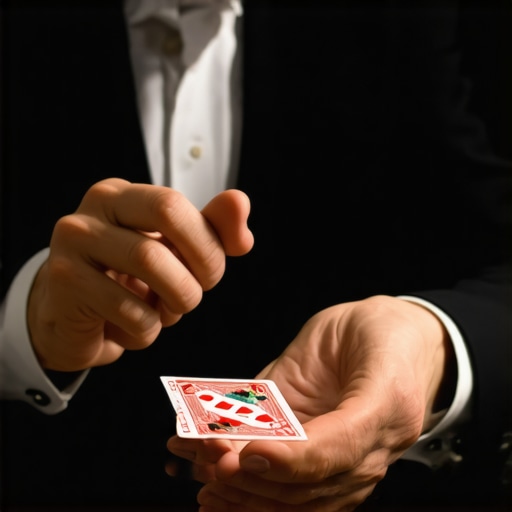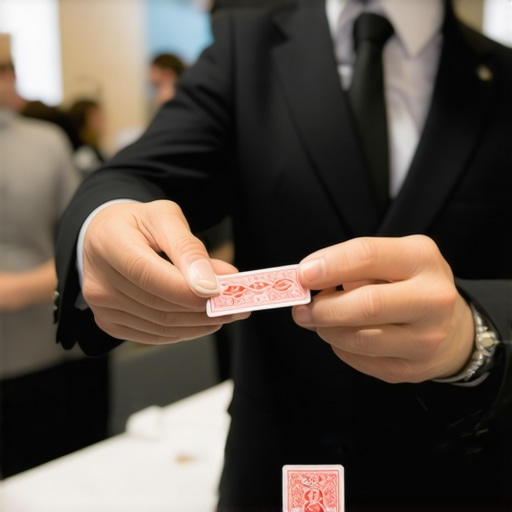My Journey into the World of Sleight of Hand at Trade Shows
As someone who has been captivated by magic since childhood, I never imagined that one day I’d be using sleight of hand to build genuine trust during high-stakes trade shows. I remember my first live performance — nerves, excitement, and a lingering fear that I might not connect with my audience. But as I practiced and honed my skills, I realized that trustworthy magic isn’t just about flashy tricks; it’s about creating a seamless experience that engages and reassures.
The Power of Authenticity in Interactive Magic
One thing I learned early on is that **trustworthiness in magic** hinges on authenticity. When I perform, I focus on clear, confident movements and genuine interactions. This approach helps break down barriers and establishes a sense of reliability. Incorporating sleight of hand naturally into my routines, I emphasize **transparency** and avoid anything that might seem overly rehearsed or deceptive. I also make sure to understand my audience’s needs, tailoring my tricks to resonate with their interests.
How I Perfected My Sleight of Hand for Maximum Impact
Practicing sleight of hand for trade shows requires dedication. I dedicated hours to mastering techniques like palming, misdirection, and quick switches — all crucial for quick, trustworthy magic. I also studied resources like Fast Magicians’ Tips for Trustworthy Close-Up Magic to refine my skills. The secret is consistency; the more natural my movements appear, the more my audience believes in what I’m doing. This trust builds rapport and makes my magic memorable.
What Makes Magic at Trade Shows Truly Effective?
Have I ever wondered why some tricks inspire more trust than others?
It’s simple — it’s all about the experience. Engaging, interactive magic that feels genuine creates an emotional connection. When I perform, I aim for that perfect balance of mystery and credibility, ensuring my audience feels both amazed and confident in my abilities. Interactive tricks, especially those involving sleight of hand, foster a sense of participation that boosts trust. You can see the difference when your audience genuinely believes in the magic — it turns a simple trick into a memorable moment.
If you’re interested in elevating your trade show game, I recommend exploring Trusted Close-Up Magic Tips for Engagement to learn more about creating authentic experiences that resonate.
Sharing My Secrets: Building Trust Through Sleight of Hand
Over the years, I’ve learned that trust isn’t built overnight. It’s a process that involves consistency, transparency, and genuine engagement. Integrating trustworthy sleight of hand into trade show magic transforms the experience into something memorable and impactful. For those looking to deepen their craft, I suggest starting with mastering basic techniques and gradually adding complexity as your confidence grows. Remember, the goal is to make every trick feel seamless and sincere.
Would you like to hear more about specific tricks or techniques? Feel free to leave a comment below or share your own experiences with interactive magic at trade shows. Together, we can continue to elevate the art of trustworthy sleight of hand!
The Nuance of Misdirection: Crafting Trust with Every Move
One of the most overlooked aspects of building trust through sleight of hand is *the art of misdirection*. When performed skillfully, misdirection doesn’t just conceal techniques; it guides the audience’s focus, fostering a sense of wonder while reinforcing credibility. As I’ve integrated this into my routines, I’ve found that subtle cues — like eye contact, deliberate gestures, or even a well-timed pause — can dramatically enhance the perceived authenticity of the magic. This aligns with insights from Mastering Sleight of Hand for Impactful Close-Up Magic, which emphasizes that mastery over focus is vital for trustworthy performance.
How Can Expert-Level Techniques Elevate Your Trade Show Magic?
What advanced sleight of hand methods can distinguish a trusted magician from an average performer?
Advanced techniques such as *double lifts, false transfers,* and *palming* with finesse can elevate your act, making it more seamless and convincing. However, the real secret lies in the *integration* of these techniques into a narrative that resonates with your audience. For instance, using a quick switch to reveal a surprise outcome builds credibility because it appears effortless and natural. To refine these skills, I recommend delving into trusted resources like Fast Magicians’ Tips for Trustworthy Close-Up Magic, which offers practical drills to sharpen precision and fluidity.
Engagement Strategies: Turning Magic into a Memorable Trust-Building Experience
Interactive magic isn’t just about the trick itself; it’s about creating shared moments. Asking questions, involving your audience, or even inviting them to examine the props fosters a sense of transparency and confidence. When performed with genuine enthusiasm and clarity, these interactions transform magic from mere entertainment into a powerful trust-building tool. For those looking to deepen their interactive approach, I suggest exploring Trusted Interactive Magic Shows for Trade Shows and Events, which offers insights on engaging audiences authentically.
Can You Leverage Psychological Principles to Enhance Trust in Your Magic?
Absolutely. Understanding the psychology behind perception and expectation allows you to craft routines that seem astonishing yet believable. Techniques like *priming* — subtly setting the stage for a particular outcome — can make your magic more impactful. For example, framing a trick as a test or a demonstration of skill can elevate your audience’s confidence in your abilities. As I continue to refine my craft, I actively study cognitive biases and perception tricks, which significantly boost trustworthiness. For a deeper dive into these principles, Trust Building with Interactive Trade Show Magic offers valuable insights.
Would You Like to Discover More Proven Techniques?
If you’re eager to explore more about how expert sleight of hand and psychological finesse can transform your trade show presence, I invite you to share your questions or experiences in the comments. Additionally, consider reading more about Mastering Sleight of Hand for Quick and Trustworthy Close-Up Magic to further elevate your craft and create authentic, impactful moments that leave a lasting impression.
The Hidden Layers of Misdirection: Crafting Subtlety for Lasting Trust
In my journey through the art of trustworthy magic, I’ve come to realize that misdirection isn’t just about hiding techniques—it’s about embedding subtle cues that foster confidence. When I perform, I pay close attention to how my gestures, eye contact, and pauses influence audience perception. Mastering this nuanced control over focus elevates my routines from mere tricks to genuine moments of wonder that reinforce trust. For example, intentionally guiding the audience’s attention to a specific prop or gesture can make the reveal appear effortless and authentic. This delicate dance of focus and distraction is a skill I continually refine, inspired by techniques outlined in Mastering Sleight of Hand for Impactful Close-Up Magic. It’s about making every move feel natural yet purposeful, creating an experience that feels both astonishing and believable.
Deepening Audience Engagement: Beyond the Tricks to Emotional Connection
Engagement at trade shows isn’t solely about executing flawless sleight of hand; it’s about building an emotional bridge. I’ve learned that sharing stories, asking thought-provoking questions, or involving the audience in the routine transforms a simple trick into a memorable exchange. This approach fosters a sense of partnership, where trust is cultivated through shared moments of awe and participation. For instance, inviting someone to examine a card or a coin before the magic occurs not only demonstrates transparency but also deepens their confidence in my honesty. These interactions, when genuine, turn passive viewers into active participants, making the magic more impactful. If you’re eager to explore more on how to make your magic resonate emotionally, I recommend reading Trusted Interactive Magic Shows for Trade Shows and Events.
Advanced Techniques for Seamless Performance: From Finesse to Authenticity
Taking my sleight of hand to an advanced level involves perfecting techniques like double lifts, false transfers, and subtle palming with finesse. But the real breakthrough comes from integrating these moves into a compelling narrative that feels natural. When I master the art of smooth execution, my routines seem effortless—no signs of complexity or rehearsed mechanics. Regular practice with a focus on fluidity, as emphasized in Fast Magicians’ Secrets for Sleight of Hand, helps me achieve this level of mastery. The goal is to make every move indistinguishable from genuine interaction, which in turn builds the audience’s trust and leaves a lasting impression.
Can Psychological Principles Transform Your Magic into a Trust-Building Tool?
Absolutely. Understanding cognitive biases and perception tricks allows me to craft routines that seem astonishing yet credible. Techniques like priming, where I subtly set expectations, or framing a trick as a demonstration of skill or insight, elevate the audience’s confidence in my abilities. For example, suggesting that a trick is a test of their perception or a display of expertise enhances their trust in me. I actively study cognitive psychology and perception biases to refine my routines, as discussed in Trust Building with Interactive Trade Show Magic. When combined with flawless technique, these psychological insights create a seamless experience where magic feels both impossible and believable.
What’s Your Next Step in Elevating Trust Through Magic?
If you’re passionate about deepening your craft and transforming your trade show magic into a genuine trust-building experience, I encourage you to experiment with these advanced techniques and psychological principles. Share your experiences or questions in the comments—learning from each other is part of the journey. For further inspiration, explore Fast Magicians’ Guide to Sleight of Hand for Trade Show Success and discover how mastery, authenticity, and engagement come together to create unforgettable moments that foster trust and connection.
Mastering the Subtle Art of Psychological Misdirection
Beyond the technical prowess of sleight of hand, the true craft lies in harnessing psychological principles to deepen trust and authenticity. Techniques like priming, where you subtly influence expectations before revealing the magic, can significantly impact audience perception. For example, framing a card trick as a demonstration of intuition rather than skill shifts the focus from deception to insight, fostering genuine confidence. Studying cognitive biases—such as the confirmation bias or the illusion of control—allows me to craft routines that resonate deeply, making the impossible seem not only believable but also personal. According to Psychology Today, understanding perception is key to creating trustful, impactful magic experiences.
How Can Leveraging Cognitive Biases Transform Your Magic Performance?
Utilizing cognitive biases transforms routine tricks into powerful trust-building tools. For instance, leveraging the anchoring effect by setting high expectations initially can make subsequent surprises more astonishing and credible. When I intentionally suggest that a choice or outcome is influenced by their subconscious, it enhances their confidence in my perceptive abilities. Integrating these insights requires deliberate practice and a nuanced understanding of audience psychology, which I continuously refine through dedicated study and experimentation. If you’re interested in exploring this further, I recommend reviewing Trust Building with Interactive Trade Show Magic for practical applications of psychological techniques in magic routines.
Refining Your Narrative: Weaving Stories into Technical Mastery
Advanced magic isn’t solely about technical finesse; it’s about storytelling that engenders trust. I’ve found that embedding routines within engaging narratives transforms a simple trick into a memorable experience. When I craft stories around my routines—perhaps framing a card reveal as a moment of insight or a demonstration of intuition—I create emotional resonance that cements trust. This narrative approach aligns with the concept that humans are naturally drawn to stories, making the magic more relatable and believable. To deepen this skill, I often revisit Fast Magicians’ Tips for Trustworthy Close-Up Magic, which emphasizes the importance of context and storytelling in establishing rapport and credibility.
Enhancing Audience Engagement Through Multisensory Cues
Engagement elevates trust by involving multiple senses and creating immersive experiences. When I involve the audience through tactile props, eye contact, and deliberate pacing, I foster a sense of shared participation. For example, inviting a volunteer to examine a coin or a card before the routine begins demonstrates transparency and invites trust. Incorporating sensory cues—such as the feel of the props or the rhythm of my speech—heightens the impact and reinforces authenticity. As outlined in Trusted Interactive Magic Shows, multisensory engagement is a cornerstone of memorable and trustworthy performances.
Can Precision and Finesse Elevate Your Routine to Unforgettable Levels?
Absolutely. Mastery over the minutiae—such as perfecting false transfers, double lifts, and seamless palms—can make routines appear effortless and natural. The key is consistent practice, focusing on fluidity and subtlety, which I achieve through meticulous drills and video analysis. When every move is executed with precision, the audience perceives authenticity, building trust that endures beyond the performance. Resources like Fast Magicians’ Secrets for Sleight of Hand offer invaluable guidance to hone these skills at an expert level.
Engaging the Mind and Heart: Creating Lasting Trust Beyond the Trick
Ultimately, the goal is to forge a genuine connection that transcends the mechanics of magic. Sharing genuine enthusiasm, asking insightful questions, and recognizing individual reactions help cultivate an environment of trust. When my routines are intertwined with sincerity and attentiveness, I transform spectators from passive viewers into active participants, reinforcing their confidence in both my craft and my character. For those eager to deepen this aspect, I recommend exploring Trusted Interactive Magic Shows for strategies that turn magic into meaningful interactions.
< >
>
Things I Wish I Knew Earlier (or You Might Find Surprising)
The Power of Genuine Connection
One surprising realization I had over the years is that trust in magic isn’t just about perfect sleight of hand; it’s about creating authentic moments. Early in my journey, I focused heavily on technical mastery, but I found that audiences respond more positively when I engage sincerely and show genuine enthusiasm. It’s like building a relationship—trust grows when people feel they’re seeing the real me behind the tricks.
Less Is Sometimes More
I used to think more complex routines meant more trust, but I learned that simplicity often has a bigger impact. Clear, straightforward tricks performed with confidence create a sense of reliability. Sometimes, a single well-executed move can be more memorable and trustworthy than a series of elaborate illusions.
The Subtle Art of Misdirection
Misdirection isn’t just about hiding techniques; it’s about guiding focus naturally. When I mastered subtle cues like eye contact and deliberate pauses, my routines felt more seamless and believable. It’s a delicate dance—making the audience focus exactly where I want them, while I perform with ease.
Storytelling Elevates the Magic
Embedding routines within engaging stories transforms a trick into a memorable experience. When I frame a card reveal as a moment of insight or intuition, it resonates emotionally. Trust builds when the audience feels involved in a narrative, not just a mechanical act.
The Psychology Behind Trust
Understanding perception and expectation is crucial. Techniques like priming or framing a trick as a demonstration of skill help boost confidence. I’ve studied cognitive biases to craft routines that seem astonishing yet credible, making the magic feel personal and believable.
Authenticity Over Perfection
One thing I wish I’d embraced sooner is that authenticity beats perfection. People can tell when you’re genuinely engaged versus just performing. When I perform with sincerity, trust naturally follows, turning spectators into allies.
Resources I’ve Come to Trust Over Time
- Psychology Today: This resource deepened my understanding of perception and biases, helping me craft routines that resonate. I recommend it to anyone interested in the psychological side of magic.
- Mastering Sleight of Hand for Impactful Close-Up Magic: A fantastic guide that refined my technical skills and taught me how to perform seamlessly. It’s become my go-to for polishing routines.
- Fast Magicians’ Tips for Trustworthy Close-Up Magic: Practical drills and tips that boost confidence and precision. I’ve found it invaluable for developing natural, trustworthy moves.
Parting Thoughts from My Perspective
Trustworthy magic at trade shows hinges on authenticity, storytelling, and a deep understanding of psychology. The most impactful performances are those where I connect genuinely with my audience, making every trick feel natural and sincere. If you’re looking to elevate your trade show game, focus on building real rapport and mastering subtle cues—these are the keys to creating memorable, trustful experiences. If this resonated with you, I’d love to hear your thoughts or experiences. Feel free to share in the comments or pass this along to someone who might find it helpful.

